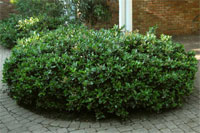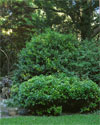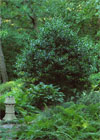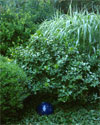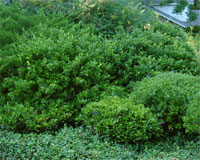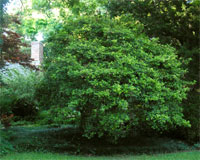From The Sperry Gardens – June, 2009
From the first week I served as Dallas County Extension Horticulturist in 1970, my good friend the late Steve Dodd, Sr. introduced me to hollies. After all, he’d come from South Alabama, from a family of nurserymen that’s renowned to this day for the hollies they grow. Steve took me aside and said, "Neil, when you recommend plants to the public, you’ll never go wrong with hollies."
That advice has served me well. In fact, I’ve broadened his comment to say that, "Wherever you live in this world, if a holly will grow there, it will be your best landscaping choice." I love hollies, and here are five of my favorites.
• Carissa holly: This has become a standard "go-to" plant for landscape architects and garden designers who need a low shrub 30 inches tall and 36 inches wide that is also adapted to both sun and shade. True, it doesn’t bear flowers or fruit, but it always has great-looking foliage. It’s the perfect step down to groundcovers and color beds. I’ve been known to buy as many as 25 Carissa hollies at a time! Photo: Carissa holly plants form mass near our front porch.
• Willowleaf, or Needlepoint holly: Selected from regular Burford holly, this one looks very similar. Its leaves, however, aren’t as decidedly cupped, giving it a more relaxed look in the landscape. It’s the ideal screen or accent shrub when you want something 6 to 8 feet tall and 6 feet wide. It grows in sun or shade, and it produces bounties of large, red berries each winter. In spite of its name, it’s not especially prickly. Photo: Willowleaf, or Needlepoint holly (behind dwarf Chinese hollies) separates two parts of our landscape.
• Nellie R. Stevens: Tom Dodd Nurseries in Alabama (one of Steve’s several brothers) put this plant on the map around 1970. Steve gave me my first one in September, 1970. It was grown single trunk, tree-form, and it’s still beautiful at our former house 39 years later. I use this as my tall, screening shrub when I need to block views or create privacy. You can maintain it at 8 or 10 feet, but it will grow to 18 or 20 feet if it’s given sufficient years to do so. Its harmless leaves are the deepest dark green, and mature plants produce very large, red berries almost every winter. It’s equally well suited to sun and shade. Photo: Nellie R. Stevens holly is my favorite tall, screening shrub.
Sadly, no longer available …
• Dazzler holly: Probably, the fact that it has very spiny leaves cost this variety its place in history. But, it’s a stunning plant that grows to 4 to 5 feet tall and wide, covering itself with huge red berries each winter. It was patented by a West Coast nursery, and when the patent ran out, so did the supply. That happened about 10 years ago. I’ve grown it for 31 years, and I’ll do all I can to get it back into the market. Photo: Dazzler holly grows on our berm in sun in mornings, shade after lunch.
• First Lady yaupon: We have a lot of need for 5-foot shrubs. Most types either grow taller than that, or they’ve been bred and selected to stay smaller. This one gets the same size as elaeagnus and standard abelia. Its leaves look like those of regular yaupon, but the internodal areas (stem spaces between the twigs) are compacted, keeping the plant really short. It fruits heavily every winter, with multitudes of tiny, red yaupon berries. It came and went quickly, also about 10 years ago. Photo: First Lady yaupons are sandwiched between our Carissa/dwarf yaupon hollies and taller Sea Green junipers.
What can you do to find a special plant? If a woody plant that you like is no longer easily available, ask your nurseryman to order it in for you. Talk to an independent retail nurseryman. They’re connected to their industry, and they often can find things that you thought were long gone. And, if you ask long enough, you may convince them to bring them back. (You might also try a Web search using the plant’s scientific name as key words. That will often take you directly to sources.)
The most expensive plant I’ve ever bought …
I needed an immediate screen for privacy from our neighboring county road, and all I could think of was a nice yaupon holly. I searched and searched, and I finally found just the right plant. But, to my horror, it was marked at $1000. I had a young family at that time and had just left Texas A&M employment to take a chance in commercial radio. That amount was several weeks’ pay. I anguished over it for 5 months, and somehow "my plant" was still waiting for me when I went back to the nursery the following spring. This beautiful male (non-fruiting) male yaupon was probably 40 years old when I bought it. I’ve had it for 30 years now. It’s a part of my family. Photo: Mature male yaupon holly is privacy screen between our house and the county road.

